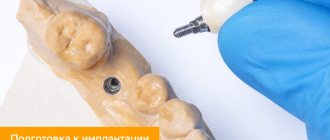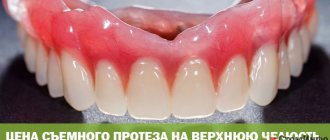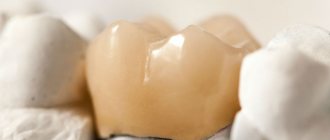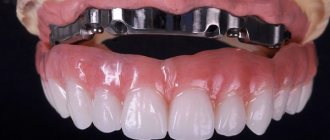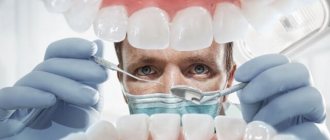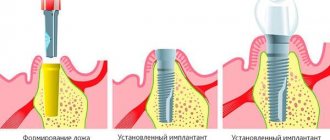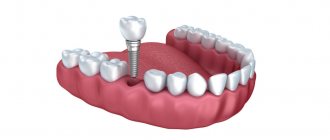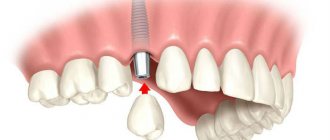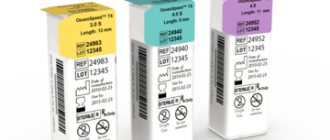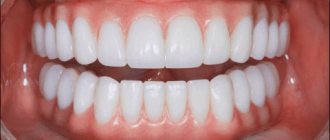Prosthetics of a full dentition with only 6 implants is a modern solution to many problems
Article navigation
- The essence of the method
- Advantages
- Peculiarities
- Implantation stages
- How are implants placed?
- Brands and models of implants
- Immediate prosthetics
- What kind of prosthesis is installed?
- Indications and contraindications
- Recovery
- All-on-4 method
- Flaws
- Alternatives
- Reviews
- Price
Question for a specialist
People with complete or almost complete absence of teeth are often offered classic removable or clasp dentures. But there is also prosthetics on implants. Although many may think that it is very expensive, because “1 implant replaces 1 tooth, and you also need to put crowns on each one.” In fact, now the installation of a large number of implants is not indicated for every patient. Often, only 6 pieces installed using the all-on-6 protocol are enough - and this amount is really enough for long-term support of the prosthesis.
All on 8 implants
Dental prosthetics using the “all-on 8 implants” technique to restore the jaw or implantation on 6 implants (All-on 6) is quite enough to thoroughly secure the future prosthesis.
This approach is explained by the need for support in each painting group of the dentition on the upper and lower jaw.
In each sector of the dentition, there are 4 main groups of teeth: lateral and central incisors, canines, premolars (small chewing teeth), molars (large chewing teeth).
Thus, jaw prosthetics using the all on 8 implantation method ensures the presence of support in each group of the dentition, which restores the natural functioning of the jawbone and promotes uniform distribution of chewing pressure over the entire surface of the jawbone, and thereby prevents resorption (loss) of bone tissue.
The option of implantation in the case of complete absence of teeth “all on 8 implants” makes it possible not to separate the molar groups and ensure that the new teeth naturally and correctly accept the functional load.
How much does it cost to install 8 implants with a prosthesis?
Jaw prosthetics with 8 Alpha Bio implants
* 14 artificial teeth
Metal ceramics standard – RUB 293,992.
Sign up for a consultation
What is the essence of the method
All-on-6 implantation is a solution that allows modern prosthetics on 6 tooth implants in patients with atrophied jaw bone tissue. All-on-6 is done in case of complete edentia - if there are completely no teeth in a row, or with almost complete edentia - if there are few teeth left (but their condition is poor and removal is required). All-on-6 implantation is called the following synonyms: “all on six implants”, “all on six”, “all-on-six”, “al-on-6”.
The “all on six” method is suitable for any jaw – upper and lower, and a specific number of implants are placed on each jaw – 6 pieces. Such implantation can be carried out for both one and both jaws at the same time.
DENTAL PROSTHESIS ON 6 IMPLANTS - 290,000 rub.
The price includes all manipulations for installing Osstem implants (South Korea), manufacturing, installing and fitting the prosthesis, including anesthesia and diagnostics.
Save RUB 30,000. >> Call now or request a call
Opening hours: 24 hours a day - seven days a week
All-on-6 refers to one-stage implantation techniques with immediate loading of the prosthesis (or Immediate Load). This means that the treatment protocol requires fixing the prosthesis on implants immediately after the surgical stage of their implantation into the bone. Although it would be fair to add that even with immediate loading, the prosthesis is usually placed not on the day of implantation (although this option is also possible), but 2-3 days later. During this time, the soft tissues recovered a little, and the implants began to strengthen (fuse with the bone), and in the laboratory they created an individual prosthesis with a solid base. But, of course, the implants will not take root completely during this time - this process traditionally takes 4-6 months. minimum.
Fixed denture on 6 implants for the upper jaw
While maintaining the adaptive properties of bone tissue, implantation of 6 implants on the upper jaw gives an advantage to the implant surgeon when choosing areas of the jaw bone for implantation of implants with the most suitable bone properties in terms of volume and structure, which allows, under certain conditions, not to carry out augmentation.
However, if such conditions do not persist, then a sinus lift is indicated for stable fixation of the implant in the bone.
Fixed prosthetics of the upper jaw on implants has a more demanding approach, since the upper jaw bone differs from the lower jaw in a thinner and looser structure.
Therefore, in the case of complete edentia, it is recommended to install more implants in the upper jaw than in the lower jaw.
The optimal number is considered to be the installation of 6 implants on the upper jaw, and for the lower jaw you can use, for example, a bar prosthesis on 4 implants.
Benefits of the concept
- suitable for difficult clinical situations,
- implants have an eternal service life: with adequate oral care,
- the prosthesis on implants does not shift and does not fall out of the mouth during its entire service life: no additional fixing creams are required,
- Implantation can be done immediately after the removal of diseased teeth and without waiting for the healing of the holes. This approach is called "one-step"
- installation is carried out using a gentle method: by puncture, without cutting the gums and splitting your own bone,
- very fast implantation and subsequent prosthetics: the prosthesis is placed almost instantly. Especially when compared with classic two-stage implantation - where a prosthesis that can be chewed normally is installed only 3-6 months after the surgical stage,
- You can chew food immediately after prosthetics,
- implantation does not require preliminary replanting of bone material in 99% of cases,
- beneficial treatment in terms of saving time and money: again, in comparison with a two-stage approach, where you will need to visit the dentist about 20 times and undergo several operations at different stages - removal of diseased teeth, bone grafting and implantation itself. With one-stage protocols, you need to visit the clinic a maximum of 5 times.
Advantages of complete prosthetics
Complete dentures, when compared with removable dentures, are quite expensive. But if you have already dealt with dentures that are removed from the oral cavity, you will remember many problems: dentures always cause discomfort (psychological), they often fall out of the mouth, they have to be regularly taken out for cleaning, and they do not look very aesthetically pleasing. And in the first few months, they cause significant speech disorders, rub lips, cheeks, and gums. Complete dentures can reduce the rehabilitation period to 1 week, and after 2 weeks the patient can eat apples and nuts with his new teeth.
Features of the preparatory stage
Before implantation using all-on-6 technology, you need to undergo a series of examinations. At the initial appointment, the implantologist examines the oral cavity, collects an anamnesis and refers the patient to a computed tomography scan of the jaw. Based on this study, a conclusion is made about bone density, its volume, location of nerves and sinuses. Next, implantation planning and creation of a virtual model of the prosthesis are carried out. After all, implants (their number, size and shape) are also selected for the future prosthesis - in order to adequately distribute the load when chewing.
Additionally, all patients undergo laboratory tests to exclude contraindications. All preparation lasts 3-14 days, depending on the clinical situation and the workload of professionals.
All-on-4 dental implantation: technology overview
When performing dental implantation using all-on-4 technology, implants are placed in a special way during implantation. Two anterior implants are implanted in the anterior jaw, two artificial roots are fixed in the bone of the posterior jaw and at an angle of thirty to forty-five degrees. This arrangement of the implants makes it possible to obtain their excellent primary stability, as well as the opportunity to install a fixed prosthesis on the implants almost immediately after surgery using the all-on-4 technology.
Placing implants in the posterior jaw at an angle also provides a certain advantage: there is no need for preliminary bone grafting. Therefore, all-on-4 implantation can be carried out even in conditions of severe atrophy of natural bone tissue.
IMPORTANT: The volume and height of the bone during implantation are of fundamental importance. If the bone does not meet a certain parameter, it will not allow the implant to be firmly fixed in the jaw. Therefore, the traditional type of implantation in 90% of cases requires a separate, additional operation to build up the jaw bone. This operation is called “bone grafting” or “osteoplasty”.
In patients with a completely edentulous jaw, bone atrophy is usually quite pronounced and the use of classical implantation would require osteoplasty, but placing implants according to a certain scheme during the all-on-4 operation allows you to avoid surgery to restore the height and volume of the bone and reduce the overall treatment time .
How are implants placed?
The long-term absence of teeth, or rather their roots, leads to the fact that the porous and capillary-pierced spongy bone (previously surrounding the root) remains without load and gradually atrophies. After 1-2 years, atrophy reaches its maximum values, i.e. it will no longer be possible to place an implant (which in most cases would be placed in the cancellous bone) strictly vertically. But with the all-on-6 technique, you can bypass such strict rules and install implants at an angle of up to 45 degrees.
When implanting teeth using the all-on-6 method, implants are implanted as follows:
- 2 models are placed vertically in the central section of the row, where the bone is usually denser and less atrophied. Therefore, implants are relatively small in size,
- Model 2 is placed obliquely in the right lateral part of the jaw: where the chewing teeth were previously located,
- Model 2 is placed obliquely in the left lateral part of the jaw: in general, in the lateral areas the bone is more atrophied (than in the frontal ones), so installing implants at an angle helps to use large areas and evenly distribute chewing loads over them.
What brands and models of implants are used?
The first implants that come to hand are not suitable for all-on-6 implantation. Indeed, here, in order to provide the patient with truly high-quality treatment, it is necessary to observe many nuances. For example, models must quickly fuse with the bone (take root). To do this, manufacturers apply active substances (calcium, fluorine and phosphorus) to the surface, creating micropores and nanostructures on it to increase the usable area. Nobel and Straumann companies have such designs.
PROSTHETICS WITH 6 OSSTEM IMPLANTS FROM RUB 200,000.
Complex implantation Osstem (South Korea) with delayed loading after 4-6 months.
Call now or request a call
Implants can be two-part root-shaped and cylindrical - on which the abutment will subsequently be fixed (the prosthesis will be attached to it). And such systems can reach up to 6 cm in length - however, these are the models that are placed only on the upper jaw, additionally passing through the force lines of the skull and cheek bones.
Also, structures can be one-piece, i.e. solid – when the implant and abutment are connected at the manufacturing stage. The most proven brand in the field of quality and reliability is the Oneway Biomed brand. An important feature of one-piece models is that they are very firmly attached to the bone due to special threads. And not in the soft spongy, but in the dense basal region and cortical plate. Also, one-piece structures often have a polished surface to which microbes do not attach - so they can be installed even with periodontal inflammation1.
Advantages of the all-on-4 technique over classical implantation and prosthetics
1. All-on-four implantation requires a much smaller number of implants. A total of 4. To carry out classical implantation with a completely toothless jaw, about 10 implants will have to be implanted under the fixation of the prosthesis, and this makes the operation both expensive and traumatic for the patient.
2. All-on-4 implantation will allow you to place a temporary prosthesis on 4 implants within a couple of hours after the operation, which can immediately be used for its intended purpose. This relieves the patient from psychological discomfort, makes it possible not to limit himself in nutrition, not to follow a diet exclusively with liquid or ground food into porridge. With classical implantation, the prosthesis is placed on the implants only after several months; this technology does not allow immediate loading of artificial roots.
What kind of prosthesis is placed on top of implants?
A full denture on implants is somewhat similar to a removable plate or acrylic denture - it also has plastic crowns, small areas of artificial gum, but there is no artificial palate at all. In the vast majority of cases, 3 days after “all-on-six” implantation, a permanent adaptive prosthesis is placed. This is a temporary solution - for 6-12 months, but can be worn for up to 3 years. Its goal is precisely adaptation.
Such a prosthesis is considered complete, because it is fixed on top of the implants (and not on the gums, as is removable) and can be used to chew almost any food. However, an adaptive prosthesis is created from softer materials (compared to a permanent one), and plastic crowns wear down a little over time. All this is necessary for the patient’s bite to smoothly return to normal. After all, a long absence of teeth leads to malocclusion and dysfunction of the temporomandibular joint. Soft materials also allow the orthopedic surgeon to easily reline the prosthesis during the correction process.
Fixed prosthesis on 6 implants
For the purpose of implantation in the complete absence of teeth using the technology of dental implantation on 6 implants, in terms of price, the most optimal option is the implantation of 2 implants in the anterior segment of the dentition in the area of the third teeth, and in the lateral segments - 4 implants in the area of the fourth and sixth teeth .
At the same time, it is possible to install the outermost implants in an inclined position, so as not to affect anatomically significant areas - these are the maxillary sinuses and the inferior alveolar nerve.
If we consider fixed (without artificial gum) prosthetics on 6 implants, then the prosthesis is fixed using a screw fastening.
Thus, three separate bridge-like fixed prostheses are installed in the jaw, all on 6 implants.
In rare cases, it is possible to use two bridges on six implants in the form of half-horses for permanent jaw prosthetics. In this case, implants are installed in the area of the first, third and sixth teeth on each side of the dentition.
Indications and contraindications for restorative treatment
Indications for implantation are complete or almost complete edentia. Implants can be placed on people over 18 years of age. Because teeth can be lost not only due to natural causes, but also as a result of injuries and progressive diseases. In general, the list of indications for all-on-6 can be supplemented with the following conditions:
- moderate bone atrophy in the lower jaw,
- moderate and severe atrophy of bone substance in the upper jaw: but not extreme,
- periodontitis and moderate periodontal disease,
- osteoporosis of the jaw,
- refusal to wear removable dentures: due to discomfort or allergies,
- patient’s refusal to undergo bone grafting and sinus lift,
- loss of teeth due to diabetes mellitus: but first you need to achieve a stable reduction in glucose levels to 6-8 mmol/l,
- facial rejuvenation: muscle smoothing occurs due to the restoration of processes in the bone substance (from implants) and support of the facial muscles, lips - from an individually designed prosthesis (for this, by the way, innovative technologies are used),
- desire to get new teeth as quickly as possible.
The list of contraindications is decreasing every year, and currently it includes the following situations:
- pregnancy and lactation: 6 months after completion of lactation, implants can be placed,
- acute period of illness and rehabilitation after it: for example, with ARVI or influenza,
- serious pathologies of the vascular, endocrine system, blood, liver and kidneys,
- oncology and radiation therapy,
- tuberculosis.
Future patients who smoke and abuse alcohol need to know that these bad habits reduce the survival rate of implants by 2 times, and therefore may cause a reduction in dental warranties. For example, the normal survival rate of implants installed using the all-on-6 protocol is 98-99%, while for smokers it is around 90-94%.
Indications for all-on-4 implantation
The use of all-on-4 dental implantation is indicated in the following cases:
— For patients with a completely toothless jaw;
- If the teeth in the rows are preserved, but they cannot support the prosthesis, as they are severely damaged or loose;
— “All on four” is an implantation technology that can be recommended to those patients who do not want to use removable dentures;
— In case of diagnosed atrophy of the jaw bone tissue and the patient’s reluctance to undergo preliminary osteoplasty.
How is the patient's recovery going?
Minimally invasive installation of implants using all-on-6 technology is an advantage for the rapid restoration of gums and bones (there are almost no injuries, there is little swelling, everything heals quickly). But since the intervention is still extensive, especially if the “deep” basal and zygomatic bones are involved, the patient must be prescribed antibacterial and antihistamine drugs.
In general, in most patients, recovery is successful within 3 days - and prosthetics can be performed. In some cases, when the mucous membranes have not yet healed well enough, prosthetics can be postponed for 1-4 days. But within a week after implantation using the all-on-6 technology, a prosthesis will be installed.
Read on the topic: how to get used to dentures - recommendations from dentists.
What are the similarities and differences with the All-on-4 method?
The similarity is primarily in the names - which is why, by the way, misunderstandings may arise. Let's deal with them. So, all-on-4 or “all on four” implantation is a patented technology of Nobel Biocare (a leader in the implantation field). Here, to support the prosthesis, 4 implants are placed on one jaw, and the side ones are implanted at an angle.
As for all-on-6 technology, in a simplified sense it is a modified all-on-4 protocol (although the “all-on-6” concept is not patented by Nobel). The method is adapted for less dense bone (and its smaller volume), i.e. for patients with more complex “baseline data” than required for all-on-4.
All-on-6 implantation: main stages
Preparing for All-on-6
At the stage of preparation for All-on-6, you need to consult an implantologist, as well as some other specialists.
Specific studies (CT, orthopantomogram) and general tests will also be prescribed. General tests are performed to exclude contraindications to All-on-6, specific diagnostics are done for detailed planning of the operation. A CT scan of the jaw allows you to see and evaluate the condition of the jaw bone tissue and, based on the data obtained, the implantologist will select implants for All-on-6 and determine the locations for their installation. If diagnostics reveals inflammatory processes in the oral cavity, they must be eliminated before All-on-6. At the All-on-6 preparation stage, surgical templates are made using a special computer program to accurately and firmly install the implants into the jaw bone.
Implant placement stage
Once the surgical templates for All-on-6 are ready, the day of the operation is scheduled. The installation of titanium rods is quick and immediately after their implantation, impressions are taken from the jaw to make a temporary prosthesis. A temporary prosthesis is usually placed on the implants 3-4 days after surgery.
Permanent prosthetics stage
A permanent prosthesis after All-on-6 implantation is placed only after the artificial roots have completely fused with the jaw bone.
This usually occurs 4-5 months after the main operation. Prostheses installed on implants with All-on-6 are non-removable structures. They are firmly fixed to the implant abutments and stay firmly in the oral cavity, and also reliably recreate the aesthetics of a smile and all the functions of lost teeth. If the prosthesis breaks or the time comes to replace it, it will be possible to install a new structure on the implants without disturbing the implanted artificial roots.
Are there any alternatives to All-on-6?
If you have a completely toothless jaw, there will be few alternatives to All-on-6: either removable dentures or All-on-4 implantation; you can also consider the option of restoring the dentition with mini-implants.
But heavy fixed prostheses cannot be placed on mini-implants, since thin and short rods simply cannot withstand such a high load. If we talk about removable prosthetics as an alternative to All-on-6, then it will be inferior to “all-on-6” implantation in a number of parameters. Removable dentures have poor aesthetics and a minimal useful life; in addition, they do not allow the restoration of the correct chewing load.
If we compare All-on-6 with all-on-4 implantation, it can be noted that All-on-6 has more advantages. Firstly, All-on-6 can be performed in cases of bone tissue atrophy, as well as periodontitis and periodontal disease, and secondly, thanks to a larger number of implants, the chewing load is distributed evenly. All-on-6 has much lower risks of complications, since every stage of the operation is planned in preparation for All-on-6.
Take a short test and calculate the cost of treatment!
Take a short test
Reviews about the All-on-6 technique
“I had bridges for many years, but at the end of their service they constantly fell out, and I was tired of constantly going to cement them. I started looking for an implantation option and consulted with probably 10 dentists. As a result, they did an “all-in-six” implantation and installed prosthetics on the third day. By then the swelling had almost gone down and nothing hurt. New teeth are just great! I can't stop looking at it. And somehow I can’t believe that nothing else in my mouth causes concern.” Svetlana V., Ekaterinburg, review from the site forum.stom.ru
“Periodontitis is an unpleasant thing. And what’s doubly unpleasant is that several clinics immediately refused to give me implantation. But through friends I found an excellent surgeon who places implants for periodontitis. At first this caused skepticism, but after the consultation there was no doubt left. We made a prosthesis using six titanium screws. They seem to be holding strong, even though 3 years have passed. And how great it was to start eating food again that you can actually chew normally – chew it with your teeth!” Vyacheslav, review from stomatologclub.ru
Cost of implantation and prosthetics
The cost of dental restoration using the all-on-6 technology for turnkey treatment includes implantation, prosthetics, and a number of clinics also include a preparatory stage (diagnosis, planning). The price of all-on-6 starts from 350 thousand rubles - which includes the price of implants, the work of doctors, an adaptive prosthesis and its adjustment.
- M. Petruska, J. Petruska. Periodontal-implantological plastic surgery, 2015.
Author: Dulgarov Zh. G. (Thank you for your help in writing the article and the information provided)
Cost of All-on-6 implantation in Moscow
The total amount, as a rule, depends on the brand of implants used, as well as on the type of prosthesis. The price when using Swiss implants, for example Roott, starts from 179,000 rubles. Implantation of premium-segment titanium roots, such as Straumann or Nobel Biocare, will cost 350,000 and 450,000, respectively.
The cost item includes diagnostics, 3D planning of the treatment process, installation of implants, creation of impressions of the jaw, production of a metal-plastic prosthesis in a dental laboratory and its fixation, guarantee. When reprosthetics requires replacement of the adaptive prosthesis, the cost of restoration depends on the material. For example, the cost of a metal-ceramic prosthesis will be about 220,000 rubles. If, according to indications and taking into account the patient’s financial capabilities, the installation of a ceramic-composite prosthesis is allowed, the cost of implantation on 6 turnkey implants (including the implantation stage) will be 290,000 rubles. The ReSmile system allows you to save on re-prosthetics, since it is not an adaptation prosthesis that is installed, but a ceramic-composite prosthesis.
